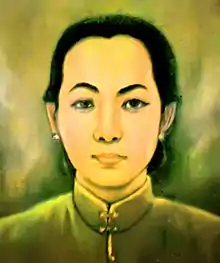Nyi Ageng Serang
Raden Ajeng Kustiyah Wulaningish Retno Edhi (1752–1838), better known as Nyi Ageng Serang, is a National Hero of Indonesia.

Biography
Nyi Ageng Serang was born under the name Raden Ajeng Kustiyah Wulaningish Retno Edhi in Serang (40 kilometres (25 mi) north of Solo), in 1752.[1][2] Her father was Pangeran Natapraja (also known as Panembahan Serang), a ruler of Serang and Pangeran Mangkubumi's war commander.[3] She was also a descendant of Sunan Kalijaga.[1] The name Nyi Ageng Serang was given to her after her father lived of disease and she took over his position.[3]
She helped her father to fight against the Dutch colonial government, which attacked them because her father still maintained troops, in violation of the Treaty of Giyanti.[4] After the battle, she was arrested and taken to Yogyakarta. Then, she was sent back to Serang.[5]
At the beginning of Diponegoro War in 1825, 73-year-old Nyi Ageng Serang commanded the force on a stretcher to help Pangeran Diponegoro fighting the Dutch. During the war, she was accompanied by her son-in-law, Raden Mas Pak-pak.[6] She also became a war advisor.[7] She fought in several areas, including Purwodadi, Demak, Semarang, Juwana, Kudus, and Rembang. She was also assigned to defend the area of Prambanan from the Dutch.[5] One of her best-known strategies was the use of lumbu (green taro leaves) for disguise. Her forces attached the lumbu to poles to look like a taro orchard.[8] She stopped fighting after 3 years, although her son-in-law continued fighting. Despite fighting the Dutch, beginning in 1833 they gave her an annuity of 100 gulden per month.[6]
She died in Yogyakarta in 1838. Her remains were buried in Beku, Kulon Progo, Yogyakarta.[9]
Legacy
Nyi Ageng Serang was awarded the title National Heroine of Indonesia through Presidential Decree number 084/TK/1974 on 13 December 1974.[6][10] One of her grandsons, Raden Mas Soewardi Soerjaningrat, is also a national hero.[6] Her name is used for the building of the Culture and Museum Office (Dinas Kebudayaan dan Permuseuman) in South Jakarta.[11]
References
- Komandoko 2006, p. 245
- Sudarmanto 2007, p. 240
- Ajisaka 2008, p. 17
- Sudarmanto 2007, pp. 240–241
- Sudarmanto 2007, p. 241
- Ajisaka 2008, p. 18
- Komandoko 2006, p. 246
- Sudarmanto 2007, p. 242
- Komandoko 2006, p. 247
- "Ahli Strategi Diponegoro". tokohindonesia.com. Retrieved 9 May 2012.
- "Nyi Ageng Serang". Ensiklopedi Jakarta. Retrieved 9 May 2012.
Bibliography
- Ajisaka, Arya (2008). Mengenal Pahlawan Indonesia. Jakarta: Kawan Pustaka. ISBN 9789797572785.
- Komandoko, Gamal (2006). Kisah 124 Pahlawan dan Pejuang Nusantara. Yogyakarta: Pustaka Widyatama. ISBN 9789796610907.
- Sudarmanto, J. B. (2007). Jejak-Jejak Pahlawan: Perekat Kesatuan Bangsa Indonesia. Jakarta: Grasindo. ISBN 9789797597160.